Halcyon Days in the Dream City
by Mrs. D. C. Taylor
Continued from Part 1

A May morning, cool but not cold, with a brisk wind, blowing, cloud shadows and sun bursts chasing one another across the deep blue sky. To-day we make our way straight from the 60th street entrance to the Midway Plaisance.
When we have passed through that tunnel like passage under the intramural railway, we have left America behind us. We are in foreign countries among foreign people. A strange, groaning, whistling noise attracts our attention, and glancing to the right, we see a tall brawny Highlander in full bravery of kilts and plaids, and what not, fingering the bag pipes and pacing swiftly to-and-fro, before the door of a large, low white building on which is painted in black letters the words, “World’s Congress of Beauty.” We approach the door, pay our entrance fee and enter.
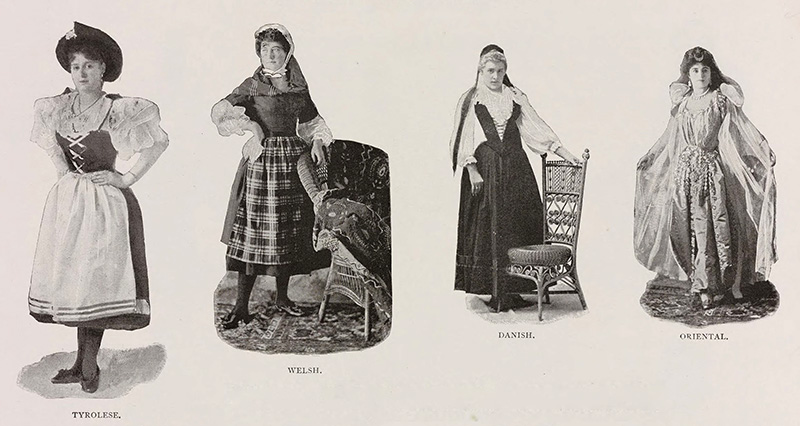
Four women in their native costumes from the Congress of Beauty. [Image from The Graphic History of the Fair. Graphic Co., 1894.]
So on we pass from face to face, country to country, all represented by ladies and young girls in appropriate costumes, but sad to say, most positively, not one beauty among the whole congress. Greece, Spain, Arcadia, Italy all represented by different costumes and all posing in many attitudes of more or less, generally LESS, grace. They sit here all day long exposed to the comments of the gazing crowd; are to sit here for six long months. Let us hope they are well paid for it.
But what is this? here in this World’s congress of Beauty! A brown Bedouin, withered and dirty, with loose hanging head cloth and wrapped in mangy looking sheep skin. A strange looking instrument like a sort of gourd covered with skin, lies at his feet. We intimate by gesture that we wish him to play upon the drum, and after a little hesitation, he takes it up and resting it upon his knees, raps upon it with the extreme tips of his long bony fingers. It gives out a dull unmusical sound to which he keeps time with his sandaled feet, and soon he breaks out into a tuneless chant, keeping perfect time however, and pausing at intervals, while the fingers still keep up the rythmic rapping. This is the music of the desert. The wild warriors listen to such sounds when they rest in the shadow of their tents upon the hot sands at noonday. No doubt the words issuing from that cavernous mouth are some wild barbaric tale of love or war; and he who utters them, has in person careered upon his steed across the yellow sweeps of plain with glittering spear and clumsy matchlock at his side. What think you of us, wild son of the desert? But he chants monotonously on with rattle of drum and beat of sandals ’till we pass beyond hearing and are outside again.
We pause to admire the Highlander who still keeps up his march before the door, and one of us recalls the day, when in far off Edinboro’ town, she saw rank upon rank, file upon file, with swinging plaids crossing brawny breasts and brown bare knees showing beneath full kilts; to the sound of squealing bag pipes the Queen’s Highlanders march bravely down the street. Then we stroll along, and as we pass the inclosure bearing the name of the ‘South Sea Islands,’ the high gate swings open, and to the rattling of drums and jingling of cowry shells, marches out a company of naked savages, girt only with little skirts of bark. What splendid looking fellows! Not one under six feet high and many more than that. Their broad bare backs and muscular arms, smooth and gleaming like yellow satin and great round heads covered with crisp, close, black wool. Their countenances are fine and benignant looking. Can these be cannibals? If so why do they not break loose and take a meal off some fine plump, juicy maiden? for surely those giant frames and terrible looking spears and clubs, could put to flight scores of these dapper little beings in coats and trousers who seem to be guiding their movements. But no! meekly they follow the bidding of the little manikins, and disappear in the interior of the South Sea Island theatre, whither we do not follow them.
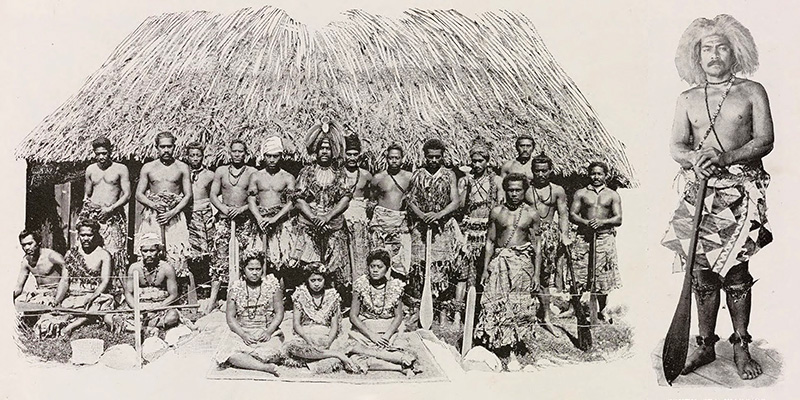
A group of South Sea Islanders and a South Sea warrior from the South Sea Island Village. [Image from The Graphic History of the Fair. Graphic Co., 1894.]
One of these ladies has a square of paper pinned up on the wall of the house, and is drawing something in blue chalk upon it. She and her companion are chatting volubly in regard to this and one of them disappears for a moment and comes back with another doll, dressed like herself. They take no more notice of us than they do of the fence, but finish their discussion and vanish. Walking along by the fence and still peeping through, we see many more of these little houses all built after the same pattern, though some are of white and red, and some blue and black. Walking about are many more of these doll like women, and little men dressed in full blue cotton trousers, and jackets like the women. Some of the women carry tiny little naked babies, but they all look miserably cold on this May day. Many of them wear colored cotton quilts pinned around their shoulders, and we see one woman with a bright pink quilt pinned about her neck and hanging straight behind her to the ground, while she shuffles dejectedly along, carrying a naked baby on one arm and a bright new tin coffee pot on the other. Poor things! How homesick they look! How they must long for their native land of warmth and sunshine! so lightly clothed and no means of warming their houses, and the sharp spring wind searching them out so keenly.
We peep in at the open door of one of the little houses, and see the inmates eating their noon meal. They sit cross-legged in a circle on the floor, around a large dish containing some kind of a white granular paste. Each one puts in his or her fingers and takes out a portion, and laying the back of the left hand upon the floor and making a hollow cup of the palm, with the right, mold and knead the paste for a moment, make it into a ball, and seem to hand it down the throat entire. They are a very busy lot, dipping, kneading, swallowing, while a gaping crowd looks in at the door. They are an industrious little people; all working like a hive of bees; some building houses, some making thatches, all at work down to a fat naked baby sitting on a mat before his father’s door, industriously gathering in a crop of pennies that the laughing crowd drops into his little fat brown hands, while his little lean brown father, unobstrusively [sic] posted in the background faithfully relieves him of his spoils. There is one language known the world over, and that is the language of mammon.
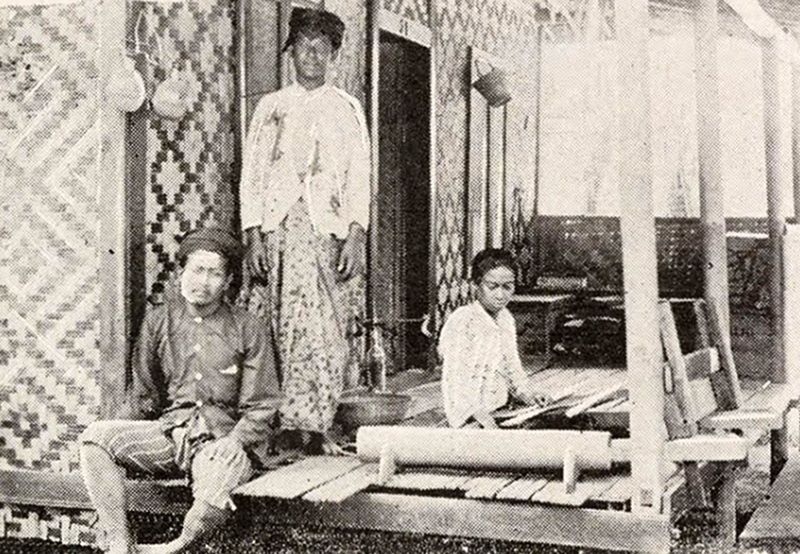
A veranda of Javanese dwelling in the Java Village. [Image from The Graphic History of the Fair. Graphic Co., 1894.]
Continued in Part 3
NOTES
[1] Mrs. Taylor’s one-sided experience of the Java Village and characterization of the occupants as “industrious little people” was a typical American response. For more on this, see Spiller, Henry Javaphilia: American Love Affairs with Javanese Music and Dance. U. Hawai‘i Press, 2015. Ch. 2 “Roots of American ‘Javas’: The 1893 World’s Columbian Exposition.”
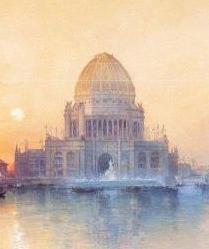
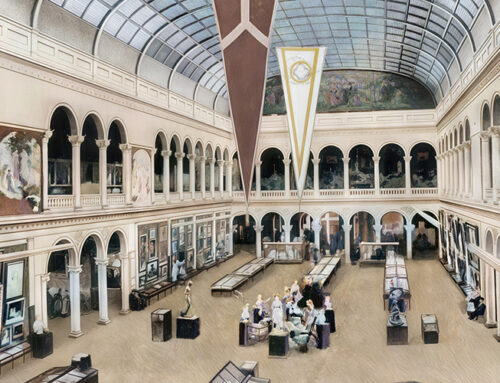
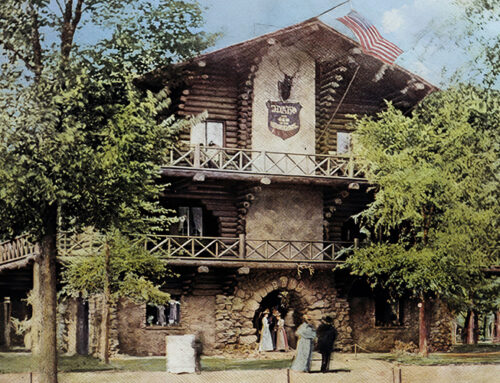
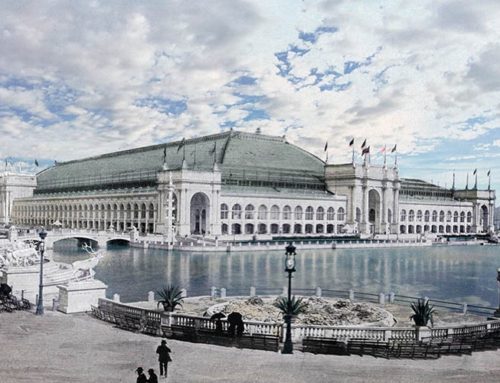

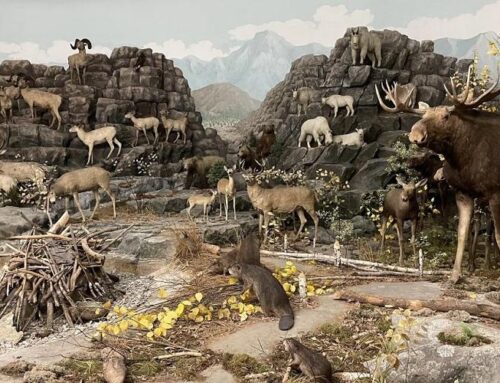
Leave A Comment